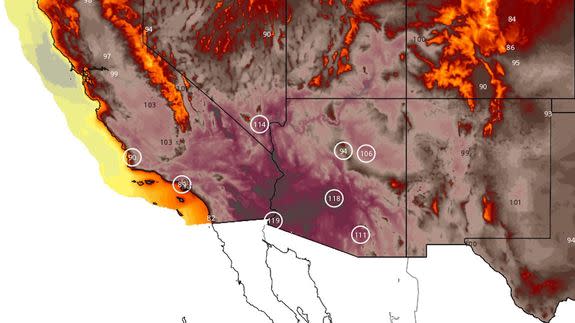Brutal and prolonged heat wave about to hit the Southwest

Residents of the Southwest U.S. are gearing up for what could be the worst heatwave to strike the region since 1990.
From Sunday through Wednesday, high temperatures in Phoenix, Arizona, could reach 120 degrees Fahrenheit, which would be only the fourth time that has happened since record taking began there.
SEE ALSO: Massive heat dome to scorch the Southwest, could smash longstanding records
Death Valley will live up to its fame as the hottest location in the U.S., with temperatures exceeding 120 degrees, while similar heat roasts California's Coachella Valley and inland portions of San Diego and Los Angeles counties.
Even Los Angeles itself, which is normally protected from heat waves by the relatively cool waters of the Pacific Ocean, could hit 100 degrees Fahrenheit early next week.

Image: Weatherbell analytics
In Phoenix, Tuscon and other parts of Arizona and Nevada, the heat could cause flight cancellations, since aircraft components can fail at such high temperatures.
In addition, extremely hot weather decreases an aircraft's ability to achieve sufficient lift on takeoff, since hot air is less dense than cold air is.
On Sunday, Monday and Tuesday, which are likely to be the hottest days in Phoenix and Las Vegas, flight delays and cancellations may occur.
Federal reports have warned that global warming, which is resulting in more frequent, severe and longer lasting heatwaves worldwide, poses risks to transportation infrastructure, including commercial aviation.
Record daily high temperatures are likely to be broken in Phoenix, Yuma and Tucson during the Sunday through Wednesday period, though it's unclear if the all-time high temperature of 122 degrees Fahrenheit, or 50 degrees Celsius, is in jeopardy.
New records are also likely to be set in New Mexico, and the heat will extend eastward into the southern Plains, with records falling in eastern Colorado, Kansas, Texas and Oklahoma as well.
However, the most headline-grabbing heat will occur in the Southwest.
Heat of this magnitude can be deadly, particularly for the elderly, small children or those with preexisting medical conditions. It can also make working outside downright perilous.
Dry heat presents different challenges compared to hot and humid conditions, which affect other parts of the U.S.
It's easier for a person to become dehydrated in such conditions, for example, and heat-related deaths spike in both types of heat waves, according to the Capital Weather Gang blog.

Image: Ross D. Franklin/AP
In issuing the Excessive Heat Warnings, the National Weather Service is warning of the deadly threats from extreme heat, advising people not to leave children or pets in a locked car outside for any length of time, among other recommendations.
A heat dome
The heat wave will be triggered by a sprawling, unusually intense area of high pressure aloft that will reroute storm systems northward toward Canada and the northern Great Lakes, while pumping hot, relatively dry air from the Southwest to parts of the Rockies and Plains states.
One metric that meteorologists use to gauge the strength of such high pressure areas is known as geopotential height, and it measures the altitude at which a particular air pressure surface can be found. With warm air masses, the air is less dense, so a column of air expands, pushing the height of a pressure surface up. With cold air, the opposite occurs.
Computer model projections have consistently shown unusually high heights associated with this high pressure area, of the sort that only occur once every several decades.
This high will weaken somewhat beyond Wednesday, but could still remain present for more than a week.
This may exacerbate the growing wildfires that are already burning across the West, potentially creating ideal conditions for the fires to grow larger and for others to ignite as well.
The heat wave, along with recent hot weather in the Plains and southern tier of the U.S., will only add to the imbalance between the number of record daily highs set or tied across the country so far this year, compared to record daily lows.
So far this year, there have been 12,407 record daily highs set or tied in the U.S., compared to just 1,973 record daily lows.
A study published Tuesday in the journal Climatic Change found that a business-as-usual emissions path would mean that by 2061-2080, summers in large parts of North and South America, Central Europe, Asia and Africa would have a greater than 90 percent chance of being warmer than any summer in the historic record.
In other words, this means that virtually every summer would be as warm as the hottest seen to date.
